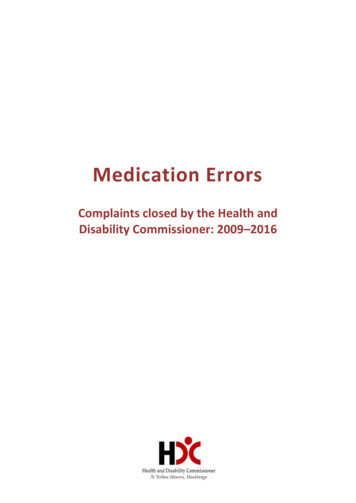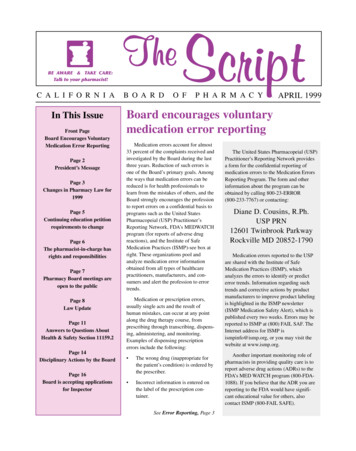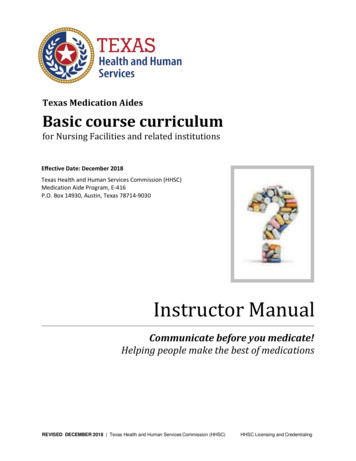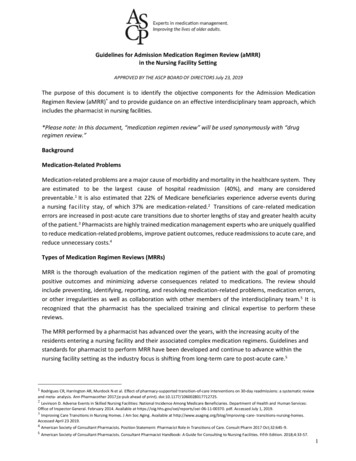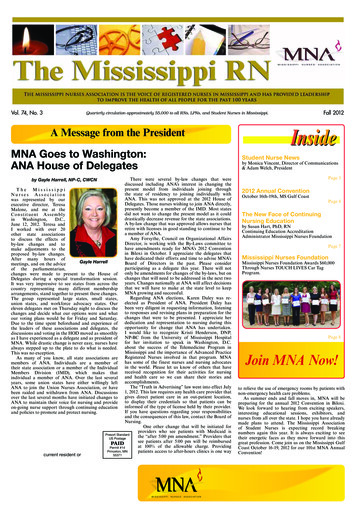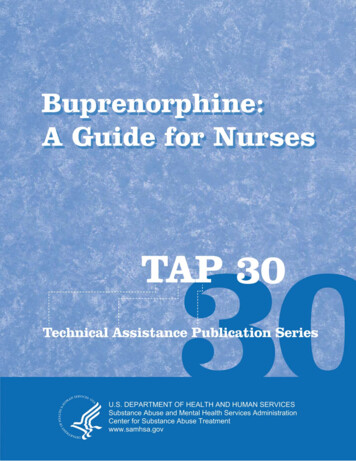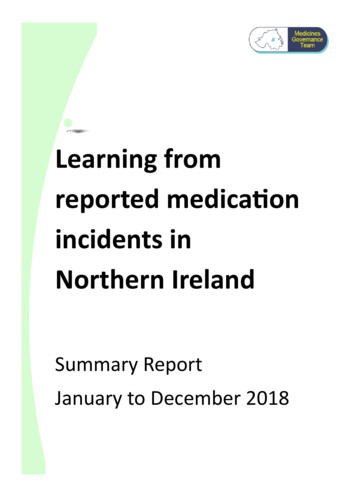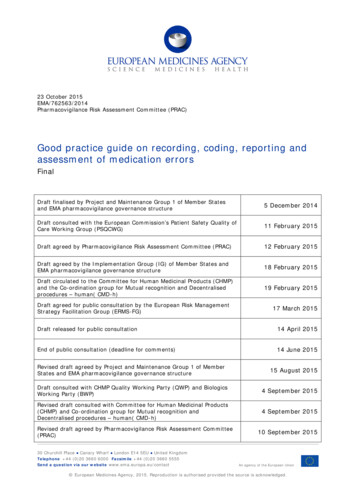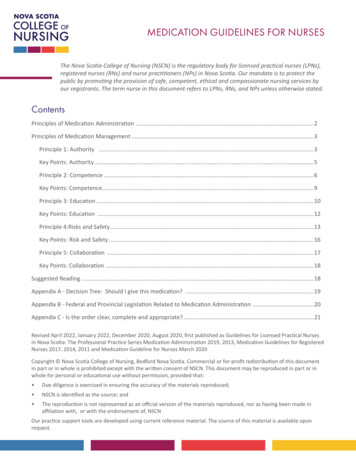
Transcription
MEDICATION GUIDELINES FOR NURSESThe Nova Scotia College of Nursing (NSCN) is the regulatory body for licensed practical nurses (LPNs),registered nurses (RNs) and nurse practitioners (NPs) in Nova Scotia. Our mandate is to protect thepublic by promoting the provision of safe, competent, ethical and compassionate nursing services byour registrants. The term nurse in this document refers to LPNs, RNs, and NPs unless otherwise stated.ContentsPrinciples of Medication Administration .2Principles of Medication Management.3Principle 1: Authority .3Key Points: Authority.5Principle 2: Competence.6Key Points: Competence.9Principle 3: Education.10Key Points: Education .12Principle 4:Risks and Safety.13Key Points: Risk and Safety.16Principle 5: Collaboration .17Key Points: Collaboration . .18Suggested Reading.18Appendix A - Decision Tree: Should I give this medication? .19Appendix B - Federal and Provincial Legislation Related to Medication Administration .20Appendix C - Is the order clear, complete and appropriate?.21Revised April 2022, January 2022, December 2020, August 2020, first published as Guidelines for Licensed Practical Nursesin Nova Scotia: The Professional Practice Series Medication Administration 2019, 2013, Medication Guidelines for RegisteredNurses 2017, 2014, 2011 and Medication Guideline for Nurses March 2020Copyright Nova Scotia College of Nursing, Bedford Nova Scotia. Commercial or for-profit redistribution of this documentin part or in whole is prohibited except with the written consent of NSCN. This document may be reproduced in part or inwhole for personal or educational use without permission, provided that: Due diligence is exercised in ensuring the accuracy of the materials reproduced; NSCN is identified as the source; and The reproduction is not represented as an official version of the materials reproduced, nor as having been made inaffiliation with, or with the endorsement of, NSCNOur practice support tools are developed using current reference material. The source of this material is available uponrequest.
This tool is a resource for nurses in all practice settings to help them understand the principals associated withmedication management. Like all regulatory tools, use this document in conjunction with employer policy,applicable legislation and the standards of practice and code of ethics for LPNs, RNs and NPs.Additional information is provided when guidancerelated to the scope of practice differs among LPNsand RNs. Information specific to the role of NPs or RNPrescribers in prescribing medication is not discussedin this tool, except as it relates to providing guidanceto RNs accepting medication orders written by NPs orRN Prescribers. Further information about the NP’saccountabilities for prescribing medications can be foundin the Nurse Practitioner Standards of Practice. Furtherinformation about the RN Prescribers accountabilities forprescribing medications can be found in the Standards ofPractice for RN Prescribers.Principles of Medication AdministrationRegistered nurses that have attainedadditional education and registrationrequirements to become a registered nurseauthorized to prescribe (RN-AP) have theauthorization to prescribe medications withintheir specific area of prescribing competenceand practice. The role of an RN Prescriberwould not replace or duplicate servicescurrently provided by nurse practitioners, butrather would complement these services andwould allow health care providers to mostappropriately treat the needs of the patient.Medication administration: the act of giving medications to an individual client through aspecific medication route (e.g., enteral, percutaneous, parenteral).Nurses are accountable to their clients to manage medication administration safely, competently, ethically andcompassionately. To fulfill this accountability, it is important that nurses consider the following principles relatedto medication management:1. Authority2. Competence3. Education4. Risk and safety5. CollaborationInterwoven within these principles is the need for nurses to consider the most appropriate care provider toadminister medications to clients. Determining the most appropriate care provider requires nurses to conduct arisk assessment. This assessment should involve the following considerations:Supports in the practice environment -accessibility of practice supportsincluding authorizing mechanisms such as policies, procedures and caredirectives Individual nurse - self-assessment of their individual competence, experience,ability to manage outcomesvironmenten clientRISKASSESSMENTpracticeNeeds of the client - known vs unknown, if the plan of care is established,predictability or consistency of client responsenurse It is important for nurses to recognize that these 3 things are interrelated and cannot be considered in isolation.More information on the scope of practice and effective utilization of LPNs and RNs can be found in the EffectiveUtilization of RNs and LPNs Practice Guideline.See Appendix A for a decision tree to assist nurses in determining if they should administer a medication.2
There are no restrictions on the types of medications LPNs can administer. There are however, certain contextsand clinical situations where LPNs may not be authorized to administer medication via a specific high-risk route.Some routes of administration, such as an IV or IV push, have a higher degree of risk associated because thepotential for untoward outcomes is greater. High-risk is associated with a greater potential for unpredictability .Principles of Medication ManagementPRINCIPLE 1: AUTHORITYA nurse’s authority to administer medication is granted through legislation, regulation and policy. Nurses must beaware of and understand the scope of practice of the nursing profession, their individual scope of practice andtheir scope of employment.1.1 Nurses must comply with federal and provincial legislative requirements for medication management.Federal and Provincial LegislationPRINCIPLE 1: AUTHORITYPrescribing, compounding, dispensing and administering medications are activities that are defined in bothfederal and provincial legislation for specified health professionals. As members of an interprofessionalcollaborative team, nurses should be aware of and understand the implications of relevant legislation, as well asthe roles and responsibilities of each team member involved in the delivery of medications to clients.Examples of relevant legislation that impact medication administration can be found in Appendix B.1.2 Nurses require an order from an authorized prescriber for all medications in schedules I or II of the DrugSchedules Regulations made under Nova Scotia’s Pharmacy Act.Authorized PrescribersIn Nova Scotia, authorized prescribers include: NPsRN armacistsNurses are authorized totake medication orders fromnurse practitioners and RNPrescribers.The type of medication that individual authorized prescribers can prescribe varies depending on theirprofessional designation, the schedule(s) of drugs they are authorized to prescribe and their scope of practice.Prescribers are accountable to know which medications they are authorized to prescribe.Types of Authorizing MechanismsMedication OrderA medication order is the direction provided by an authorized prescriber for a specific medication to beadministered to a specific client. Medication orders may be received in writing or electronically or deliveredverbally in-person or by telephone.Acceptable forms of medication orders include: PrescriptionsOrders in the client recordCare directivesPre-printed ordersCopy of a pharmacy telephone order3
A complete medication order must include: Client’s full name Date of order Medication name Frequency Strength, quantity and concentration, where applicable Route of administration Purpose for a PRN medication Authorized prescriber’s name, signature and designationOrders such as “providemedications at home”, “resumemedications as pre-op”, or “resumemedications post-discharge”are not acceptable as they areincomplete and can lead to errors .When the order is intended for a client to use at home, the order must include: the dosage with instructions; including frequency, interval or maximum daily dose how long the drug is to be used, where applicablePRINCIPLE 1: AUTHORITYCare DirectivesA care directive is an employer policy developed in consultation with an authorized prescriber for an interventionor series of interventions to be implemented by another care provider for a range of clients with identifiedhealth conditions or needs when specific circumstances exist. The intervention(s) must be within the scope ofpractice of the care provider implementing them. The authorized prescriber who writes the order holds theultimate responsibility for the interventions. Refer to Care Directives Practice Guideline and employer policy forfurther guidance.Pre-Printed OrdersA pre-printed order is a list of orders for a specific client for a specific health condition from which the authorizedprescriber selects the applicable orders. Pre-printed orders must: Include the client’s identifying information (e.g. name, ID number) Include the signature of the authorized prescriber Be included in the client’s health recordWhen pre-printed orders are used, the client is first assessed by the authorized prescriber who then selects theappropriate interventions from a set of pre-printed orders. These orders are to be implemented as written unlessthe nurse determines a client-specific contraindication (e.g. allergy).See Appendix C for guidance to determine if an order is clear, complete and appropriate.Over the Counter Medications and DevicesOver the counter medications (OTC) including herbal medications and OTC devices such as wound care ordiabetic supplies, do not require a prescription and are not part of the act of prescribing.RN PRACTICERNs may recommend and administer OTC medications or devices as long as they have the knowledge, skilland judgement (competence) to do so. The RN must ensure the recommended OTC medication or deviceis treating an already diagnosed condition and not new symptoms which would require further assessmentby an NP, RN-AP or medical practitioner. Nurses cannot personally gain from the promotion of anyrecommended OTC medications and devices as per the Nursing Act.LPN PRACTICELPNs are authorized to recommend OTC medications or devices only in the limited specific context ofadvanced foot care practice, as long as they have the competence to do so. There must be employer policyto support this practice.Refer to the Nurses Recommending and Administering Over the Counter Medications or Devices PracticeGuideline for further information.4
1.3 Nurses do not compound or dispense medicationsCompoundingCompounding involves the preparation of medication(s) that contain individual ingredients that are mixedtogether in the exact strength and dosage form to meet the client’s unique needs. Compounding is not withinthe scope of nursing practice.Crushing medications, reconstituting medications for parenteral administration or mixing two different types ofinsulin are not considered compounding.DispensingPRINCIPLE 1: AUTHORITYDispensing is the interpretation, evaluationand implementation of a prescription drugorder, including the preparation, packaging,labeling and delivery of a drug or devicein an appropriately labeled container foradministration and/or use by a client.Dispensing is not within the scope of nursingpractice.Repackaging or providing medications afterthey have been dispensed by a pharmacy isconsidered ‘supplying’ not dispensing and istherefore within the nursing scope of practice.Other situations that are often incorrectlyreferred to as dispensing include:The Food and Drug Regulations permit the distributionof drugs samples to and by authorized prescribers.Employer policy is required to support NPs to distributedrug samples.RNs and LPNs can only distribute drug samples underan authorized prescriber’s order or care directive.Agency policies pertaining to the distribution of drugsamples should address their procurement, storage,access, distribution/supplying and proper disposal.RN Prescribers are not authorized to dispense drugsamples without a physician’s order. Filling a mechanical aid or alternative container from a client’s own blister pack or prescription bottle tofacilitate self-administration or administration by a caregiver. Repackaging and labeling drugs from a client’s own supplies. Administering medications prepared by a pharmacy. Administering medications from a stock supply (dispensed by pharmacy). Providing clients with their own blister packs or prescription bottles. Providing clients with medications obtained from a ward stock or ‘night cupboard’. Providing medications from an agency pharmacy upon a client’s discharge from an institution when they areunable to get their medications from their community pharmacy.These are all within the professional scope of practice of nursing as long as the nurse has the requiredcompetencies and follow employer policy.Key Points: Authority Nurses must be aware of and comply with federal and provincial legislation Examples of relevant legislation that impact medication administration can be found in Appendix B. Nurses require an order from an authorized prescriber which could be a direct order, a pre-printed order, ora care directive Nurses should be aware of the differences in scope of practice related to the recommendation andadministration OTC medication and devices. Nurses should be aware of what is meant by compounding and dispensing and how this may impact theirpractice.5
PRINCIPLE 2: COMPETENCE2.1 Nurses are required to have the knowledge, skills and judgement to safely administer medications.Medication CompetenciesPRINCIPLE 2: COMPETENCEIn order to safely and competently administer medications, nurses need the knowledge, skills and judgment to: Obtain a complete medication history from clients, including medication reconciliation. Determine that each medication order is clear, accurate, current and complete; and take appropriate actionif clarification is needed (see Appendix C). Assess the appropriateness of a medication for a client, considering the client’s age, weight, pathophysiology,laboratory data, medication history, allergies, vital signs and knowledge/beliefs about drugs(see Appendix C). Discuss concerns about medication orders with the appropriate interprofessional team member in order toappropriately prepare and administer medications. Ensure medication orders are transcribed according to employer policy. Have knowledge about the medication(s) being administered, including therapeutic actions, possible risks,adverse effects, contraindications and interactions with other substances. Administer medications correctly. Obtain informed consent before administering medications. Monitor the effectiveness of medications. Manage adverse reactions. Consult with the appropriate care provider when clientoutcomes are not as expected, or client needs exceed thescope of practice of the nurse. Accurately document outcomes. Teach clients how to manage their own health, includingmedications.Medication reconciliation: a systematicprocess used to obtain a completeand accurate current list of a client’smedications, i.e., name, dose, frequency,route, which is then compared to aphysician’s admission, transfer anddischarge medication orders to identifyand resolve any discrepanciesIt is important for nurses to identify the needs of the client, the supports in the practice environment and thescope of practice of the individual nurse when determining who is the appropriate nurse to administer thespecific medications.See Appendix A for a decision tree to assist you in determining if you are the most appropriate nurse toadminister a medication.Medication RightsSafe and competent medication administration requires the application of a safety framework or the “9 Rights”to the medication administration process: Right client Right time Right response Right medication Right dose Right education Right route Right reason Right documentation6
2.2 Nurses use their knowledge, skills and judgment and work within their legislated scope of practice whenimplementing orders for medications which require nurses to determine doses and administration times.PRN MedicationsPRN or “as needed” medications are administered to clients following a comprehensive nursing assessment andare given only for the purpose for which they are ordered.Nurses are then responsible to monitor the client to determine the medication’s effectiveness and document theoutcomes.An order for a PRN medication should include: Purpose of the medication Frequency with which it may be administeredWhen a PRN medication is administered, the reason for its administration and the client’s response should bedocumented.PRINCIPLE 2: COMPETENCEPRN medication orders must be administered as ordered; for example: if the order is for morphine 2mg every 4hours, the nurse cannot give 0.5mg every hour. If the PRN order is not meeting the clients’ needs, the nurse mustcollaborate with the authorized prescriber and have the order re-evaluated to ensure the client’s needs are met.Range DosesRange doses refer to medication orders in which the dose and frequency of medication is prescribed in a range(e.g., acetaminophen 500 - 1000 mg PO Q4-6H as needed for pain). These range doses are often prescribed whena client’s need for medication varies.Comprehensive client assessments are critical when administering range doses, including the client’s responseto previous doses of the medication. If the nurse determines the range dose prescribed is inadequate in meetingthe client’s needs, they should contact the prescriber. Clear communication among clients, nurses, physiciansand pharmacists is vital for a range dose system to work effectively.RN PRACTICERNs are authorized to administer range doses for clients in any context of practice as long as the RNpossesses the required competencies.LPN PRACTICEIndependent PracticeLPNS are authorized to administer range doses as part of a well-established plan of care with readilyanticipated outcomes based on a discussion with the client and using the effectiveness of any previousdosages as a reference point.Collaborative PracticeWhen the client’s need for a range dose has changed, become more frequent or less effective, the LPN isexpected to consult with the RN to collaboratively determine the range dose.Sliding Scales and AlgorithmsSome medications may be ordered according to a sliding scale or algorithm. These tools guide nurses indetermining the dose of a medication based on a client’s laboratory values or other parameters. Nurses must beaware of employer policy regarding the use of sliding scales and algorithms and ensure that these policies arecurrent and based on evidence.7
RN PRACTICERNs are authorized to administer medications using sliding scale and/or algorithms as long as they possessthe required competencies. RNs should self-assess their competence and seek additional education ifrequired. Additionally, the employer may require the RN to participate in employer-based education prior toengaging in these skills.LPN PRACTICEIndependent PracticeLPNs are authorized to administer medications using sliding scale and/or algorithms in the appropriatecontext, including where: A baseline of assessment parameters has been established and documented in the client’s plan of care The algorithm is part of a well-established plan of care for a client whose outcomes are reasonablyanticipated The LPN has the appropriate knowledge, skill and judgment.LPNs are required to participate in employer-based education before they can engage in these skills.PRINCIPLE 2: COMPETENCECollaborative PracticeWhen the client’s needs are not established, well known or easily anticipated or if findings in relation to theassessment parameters are unpredictable or frequently changing, the LPN is expected to use the sliding scaleor algorithm in consultation with the RN.Not AuthorizedLPNs are not authorized to determine insulin correction or adjustment doses using protocols or caredirectives.2.3 Nurses document all aspects of medication administration.Transcribing Medication OrdersTranscribing is the process of transferring a prescriber’s medication order from an order sheet to the medicationadministration record (MAR). When transcribing medication orders and determining the appropriateadministration schedule, nurses must apply professional judgment to maximize the therapeutic effect of thedrug, support client choice and comply with employer policy.In some practice settings, other individuals, such as ward clerks or other clerical staff, may participate incompleting the paperwork involved in transcribing orders. Nurses are accountable for validating the accuracyand completeness of the transcription before the administration of medications to the client.Before administering the medication(s), nurses are responsible to assess the medication appropriateness andverify that the medication orders, pharmacy labels or medication administration records are accurate andcomplete, including the client’s name and identification number, as well as the medication’s name, strength,dose, route, timing and frequency of administration, as per employer policy.LPN PRACTICECollaborative PracticeLPNs are authorized to transcribe orders for medications they cannot administer, as long as they canadminister the medication via another route. For example IV metoprolol- the LPN may not be authorized toadminister the metoprolol intravenously but can give it orally and therefore can transcribe the order. In thesecases, the LPN is accountable to make sure their transcription is verified by an RN.8
DocumentationDocumentation of medication administration usually takes place in the medication administration record butcould also be within the notes section of the client record. Nurses are accountable for ensuring timely, accuratedocumentation of all medications they administer. All documentation of medication administration shouldinclude: Client’s name Name of drug(s) Date and time of administration Dose Route Site (as applicable) Nurses signature/designation as per employer policyPRINCIPLE 2: COMPETENCENurses are required to document: Any adverse reactions to medication The client’s response, Any related interventions Information provided to a client and communications with other members of the healthcare team.For further information, please refer to the Documentation Guidelines for Nurses Practice Guideline and theemployer policy.Documenting Medications Administered by OthersEmergenciesNurses should only document medications that they have personally administered and should not permit anyoneelse to document for them except in an emergency. For example, in a cardiac arrest, a healthcare provider isusually designated to record all medications given by team members. However, the healthcare providers whoactually administer the medications should countersign this record as soon as possible after the event.Self-MedicationIn certain care contexts, clients may self-administer medications; however, as the nurse caring for the client, thenurse maintains responsibility for monitoring and documenting the client’s medication usage. Employer policyshould be in place to support this practice.StudentsWhen working with nursing students, nurses should be knowledgeable about policies pertaining to theadministration of medications by them, including any restrictions placed on students’ practice. The nursingstudent should document in the medication administration record (MAR) and the entry should not be co-signedas this blurs the lines of accountability.Key Points: Competence Nurses are required to have medication competence and be aware of the 9 medication rights Nurses should be aware of the differences in scope of practice related to implementing orders whichrequires them to determine doses and administration times such as PRN meds, range doses sliding scale andalgorithms. Nurses are required to document all aspects of medication administration which includes transcription,documenting in the client record and the medication administration record9
PRINCIPLE 3: EDUCATION3.1 Nurses seek knowledge when administering non-traditional medications.Complementary and Alternative MedicationsBefore administering complementary and alternative medications or providing advice about their use, nursesmust have a prescription from an authorized prescriber and be knowledgeable about the therapeutic benefits,side effects, contraindications and potential interactions with other prescribed medications. Further informationon your roles and responsibilities in relation to complementary and alternative medications are outlined inComplementary & Alternative Health Care: A Guideline for Nurses .Investigational MedicationsInvestigational medications are used in human clinical trials and must be approved by an independent researchethics board. These medications require an order and additional written consent, the process for which must beoutlined in the research protocol.RN PRACTICEPRINCIPLE 3: EDUCATIONRNs may only administer investigational medications to those clients involved in the clinical trial and areaccountable to apply the principles of safe medication administration, including carefully monitoring clientoutcomes and documenting relevant findings as outlined in the research protocol.LPN PRACTICECollaborative PracticeLPNs are authorized to administer Phase III investigational medications administered via the PO, IM or subcutroute, but not via the IV route Employers and LPNs wishing to engage in practice must consult an NSCNPractice Consultant for guidance in developing policies and processes.Restricted, Non-Formulary and Special Access Medications/Emergency Release MedicationsNurses may be requested to administer: Restricted medications: formulary medications that are restricted for a specific indication or specialty. Non-formulary medications: not on an employers formulary or approved for general use and requires specialauthorization. Special access medications: only authorized through the Special Access Program of Health Canada, for usein serious or life-threatening conditions for which conventional therapies have failed or are unsuitable orunavailable.RN PRACTICERNs are required to have an order and a signed and dated client consent form before administering anyrestricted, non-formulary or special access medications.LPN PRACTICECollaborativeLPNs may administer restricted and non-formulary medications when the administration of the medication ispart of an established plan of care with clear and predictable client outcomes.Not AuthorizedLPNs are not authorized to administer Special Access/Emergency release medications.10
Off-Label Use of MedicationsOff-label use of medications refers to the practice of using a Health Canada-approved drug for a purpose that isnot indicated by the manufacturer but has been deemed potentially beneficial by the prescriber for a client.Nurses should be knowledgeable about the scientific rationale for the off-label use of a medication as well asthe possible side effects. Prior to administering an off-label medication, nurses may need to speak with theprescriber or a pharmacist if there are any questions or concerns. Nurses also need to communicate to the clientthe reason for the off-label use of a medication and associated risks.See Appendix C if you have questions related to the use of off-label medications.LPN PRACTICECollaborativeLPNs are required to collaborate with the RN when administering medications for an off-label use.3.2 Nurses know the limits of their knowledge, skills and judgement and seek assistance and additionalknowledge as needed.PRINCIPLE 3: EDUCATIONProcedural Sedation and AnalgesiaProcedural sedation and analgesia (PSA) is used to control pain o
Revised January 2022, December 2020, August 2020, first published as Guidelines for Licensed Practical Nurses in Nova Scotia: The Professional Practice Series Medication Administration 2019, 2013, Medication Guidelines for Registered Nurses 2017, 2014, 2011 and Me



